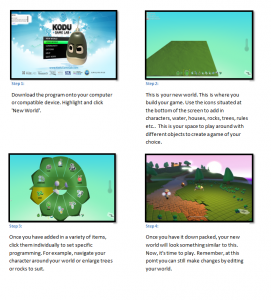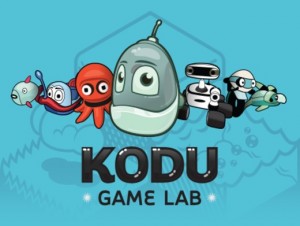Subject: Digital Technologies
Strand: Digital Technologies Processes and Production Skills
Sub Strand: Implement digital solutions as simple visual programs involving branching, iteration (repetition), and user input (ACTDIP020)
- planning and implementing a solution using a visual programming language, for example designing and creating a simple computer game involving decisions and repetitions, suitable for younger children, that requires user input to make selections, taking into account user responses
- designing and creating a solution that is interactive, using a visual programming language, for example designing a user interface for people with disability, taking into account visibility and size of icons; or creating a quiz that provides feedback on response and allows the user to try again
Link to Resource
Download: https://www.microsoft.com/en-au/download/details.aspx?id=10056
Information: http://www.kodugamelab.com/
Cross Curricular Priorities and General Capabilities:
- Literacy
- Numeracy Numeracy
- Critical and creative thinking Critical and creative thinking
- ICT capability Information and Communication Technology (ICT) capability
Links to other learning areas:
- English
- Mathematics
Kodu is an interactive visual programming resource that provides its users with the opportunity to create games on any PC and Xbox device via a simplistic visual programming language system. Inspired by other online gaming programs, it’s unique programming model is simplified and is designed to be accessible by anyone. From young children to the extreme online gamers, everyone at any level is welcome and best of all, it is free!
Kodu can be included into any classroom environment and can be easily integrated into multiple aspects of the curriculum. Not only can it assist in the development of computing programming and gamming skills but can be used to teach creativity, problem solving and storytelling too.
Unique to its design, Kodu can be used to create a variety of different games for multiple purposes. Specifically within the classroom, Kodu can be used to plan, design and create a simple computer game, using visual programming language for people with a disability, taking into account visibility and size of icons, as well as sound and verbal cues.
Types of Games:
- Adventure
- Platform
- Puzzle
- Racing
How to use this resource:
Below is a series of images designed to assist you in getting started.

System Requirements
In order to access and download Kodu, please ensure your computer or device is compatible with one of the following:
Operating Systems:
- Windows 8 or 8.1 (Desktop mode)
- Windows 7
- Windows Vista
- Windows XP (latest updates required)
Additional requirements:
- A graphics card that supports DirectX 9.0c and Shader Model 2.0 or higher
- .NET Framework 4.0 or higher
- XNA Framework 4.0 Redistributable
Enjoy! Talia Townshend


